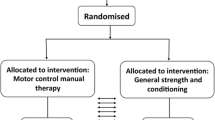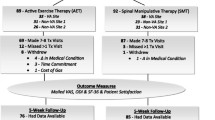Abstract
Purpose
Exercise therapy such as motor control training (MCT) has been shown to reduce pain and disability in people with low back pain (LBP). It is unknown which patients are most likely to benefit. This longitudinal cohort study aimed to: (1) retrospectively examine records from a large cohort of patients who received MCT treatment, (2) identify potentially important predictors of response to MCT and (3) test the predictors on an independent (split) sample derived from the original cohort of patients, using one group to identify the predictors and the other to test them.
Methods
The response of 775 patients with LBP to MCT was classified as ‘improved’ or ‘not improved’ based on self-reported change in pain levels and symptoms. Measures were examined for associations with improvement and entered into a logistic regression model to classify patients as low, medium or high benefits of improvement with MCT. The model was tested on an independent sample.
Results
A positive response was seen in patients with: no evidence of scoliosis [OR = 4.0, 95% CI (1.7, 9.6)], LBP without associated groin pain [OR = 2.2, 95% CI (1.0, 5.0)], LBP which was chronic recurrent in nature [OR = 3.1, 95% CI (1.8, 5.3)] and poor results on muscle testing of the multifidus muscle [OR = 2.0, 95% CI (1.1, 3.7)]. Testing on an independent sample confirmed that patients could be classified into benefit groups.
Conclusions
This study provides a first step towards assisting clinicians to select patients most likely to respond to MCT.
Graphical abstract
These slides can be retrieved under Electronic Supplementary Material.

Similar content being viewed by others
References
Foster NE, Anema JR, Cherkin D, Chou R, Cohen SP, Gross DP, Ferreira PH, Fritz JM, Koes BW, Peul W, Turner JA, Maher CG (2018) Prevention and treatment of low back pain: evidence, challenges, and promising directions. Lancet (London, England) 391(10137):2368–2383. https://doi.org/10.1016/s0140-6736(18)30489-6
Searle A, Spink M, Ho A, Chuter V (2015) Exercise interventions for the treatment of chronic low back pain: a systematic review and meta-analysis of randomised controlled trials. Clin Rehabil 29(12):1155–1167. https://doi.org/10.1177/0269215515570379
Saragiotto BT, Maher CG, Yamato TP, Costa LO, Costa LC, Ostelo RW, Macedo LG (2016) Motor control exercise for nonspecific low back pain: a cochrane review. Spine (Phila Pa 1976) 41(16):1284–1295. https://doi.org/10.1097/brs.0000000000001645
Hides JA, Donelson R, Lee D, Prather H, Sahrmann SA, Hodges PW (2019) Convergence and divergence of exercise-based approaches that incorporate motor control for the management of low back pain. J Orthop Sports Phys Ther 49(6):437–452. https://doi.org/10.2519/jospt.2019.8451
Hides JA, Stanton WR, Mendis MD, Gildea J, Sexton MJ (2012) Effect of motor control training on muscle size and football games missed from injury. Med Sci Sports Exerc 44(6):1141–1149. https://doi.org/10.1249/MSS.0b013e318244a321
Borkan JM, Koes B, Reis S, Cherkin DC (1998) A report from the second international forum for primary care research on low back pain. Reexamining priorities. Spine 23(18):1992–1996
Henschke N, Maher CG, Refshauge KM, Herbert RD, Cumming RG, Bleasel J, York J, Das A, McAuley JH (2009) Characteristics of patients with acute low back pain presenting to primary care in Australia. Clin J Pain 25(1):5–11. https://doi.org/10.1097/AJP.0b013e3181817a8d
Delitto A, Erhard RE, Bowling RW (1995) A treatment-based classification approach to low back syndrome: identifying and staging patients for conservative treatment. Phys Ther 75 (6):470-485. (discussion 485–479)
McGinn TG, Guyatt GH, Wyer PC, Naylor CD, Stiell IG, Richardson WS (2000) Users' guides to the medical literature: XXII: how to use articles about clinical decision rules. Evidence-Based Medicine Working Group. Jama 284(1):79–84
Hides J, Stanton W, Dilani Mendis M, Sexton M (2011) The relationship of transversus abdominis and lumbar multifidus clinical muscle tests in patients with chronic low back pain. Man Ther 16(6):573–577. https://doi.org/10.1016/j.math.2011.05.007
Scott J, Huskisson EC (1976) Graphic representation of pain. Pain 2(2):175–184. https://doi.org/10.1016/0304-3959(76)90113-5
Roland M, Morris R (1983) A study of the natural history of back pain. Part I: development of a reliable and sensitive measure of disability in low-back pain. Spine (Phila Pa 1976) 8(2):141–144
Stevens ML, Lin CCW, Maher CG (2016) The Roland Morris disability questionnaire. J Physiother 62(2):116. https://doi.org/10.1016/j.jphys.2015.10.003
Baecke JA, Burema J, Frijters JE (1982) A short questionnaire for the measurement of habitual physical activity in epidemiological studies. Am J Clin Nutr 36(5):936–942
Florindo AA, Latorre Mdo R, Santos EC, Negrao CE, Azevedo LF, Segurado AA (2006) Validity and reliability of the Baecke questionnaire for the evaluation of habitual physical activity among people living with HIV/AIDS. Cad Saude Publica 22(3):535–541.https://doi.org/10.1590/S0102-311x2006000300008
Menezes Costa LDC, Maher CG, Hancock MJ, McAuley JH, Herbert RD, Costa LOP (2012) The prognosis of acute and persistent low-back pain: a meta-analysis. CMAJ 184(11):E613–E624. https://doi.org/10.1503/cmaj.111271
Kongsted A, Hestbaek L, Kent P (2017) How can latent trajectories of back pain be translated into defined subgroups? BMC Musculoskelet Disord. https://doi.org/10.1186/s12891-017-1644-8
Hides J, Gilmore C, Stanton W, Bohlscheid E (2008) Multifidus size and symmetry among chronic LBP and healthy asymptomatic subjects. Man Ther 13(1):43–49. https://doi.org/10.1016/j.math.2006.07.017
Hides JA, Richardson CA, Jull GA (1995) Magnetic resonance imaging and ultrasonography of the lumbar multifidus muscle. Comparison of two different modalities. Spine 20(1):54–58
Ostelo RWJG, Deyo RA, Stratford P, Waddell G, Croft P, Von Korff M, Bouter LM, De Vet HC (2008) Interpreting change scores for pain and functional status in low back pain: towards international consensus regarding minimal important change. Spine 33(1):90–94. https://doi.org/10.1097/BRS.0b013e31815e3a10
Hides JA, Richardson CA, Jull GA (1996) Multifidus muscle recovery is not automatic after resolution of acute, first-episode low back pain. Spine 21(23):2763–2769. https://doi.org/10.1097/00007632-199612010-00011
Wallwork TL, Stanton WR, Freke M, Hides JA (2008) The effect of chronic low back pain on size and contraction of the lumbar multifidus muscle. Man Ther 14(5):496–500. https://doi.org/10.1016/j.math.2008.09.006
Hodges PW, Galea MP, Holm S, Holm AK (2009) Corticomotor excitability of back muscles is affected by intervertebral disc lesion in pigs. Eur J Neurosci 29(7):1490–1500. https://doi.org/10.1111/j.1460-9568.2009.06670.x
Hodges PW, James G, Blomster L, Hall L, Schmid A, Shu C, Little C, Melrose J (2015) Multifidus muscle changes after back injury are characterized by structural remodeling of muscle, adipose and connective tissue, but not muscle atrophy: molecular and morphological evidence. Spine 40(14):1057–1071. https://doi.org/10.1097/brs.0000000000000972
Zhao W-P, Kawaguchi Y, Matsui H, Kanamori M, Kimura T (2000) Histochemistry and morphology of the multifidus muscle in lumbar disc herniation: comparative study between diseased and normal sides. Spine 25(17):2191–2199. https://doi.org/10.1097/00007632-200009010-00009
Hides JA, Stanton WR, McMahon S, Sims K, Richardson CA (2008) Effect of stabilization training on multifidus muscle cross-sectional area among young elite cricketers with low back pain. J Orthop Sports Phys Ther 38(3):101–108. https://doi.org/10.2519/jospt.2008.2658
Nitz AJ, Peck D (1986) Comparison of muscle spindle concentrations in large and small human epaxial muscles acting in parallel combinations. The American surgeon 52(5):273–277
Kiefer A, Shirazi-Adl A, Parnianpour M (1997) Stability of the human spine in neutral postures. Eur Spine J: Off Publ Eur Spine Soc, Eur Spinal Deform Soc, Eur Sect Cerv Spine Res Soc 6(1):45–53
Welch N, Moran K, Antony J, Richter C, Marshall B, Coyle J, Falvey E, Franklyn-Miller A (2015) The effects of a free-weight-based resistance training intervention on pain, squat biomechanics and MRI-defined lumbar fat infiltration and functional cross-sectional area in those with chronic low back. BMJ Open Sport Exer Med 1(1):e000050–e000050. https://doi.org/10.1136/bmjsem-2015-000050
Hides JA, Belavý DL, Stanton W, Wilson SJ, Rittweger J, Felsenberg D, Richardson CA (2007) Magnetic resonance imaging assessment of trunk muscles during prolonged bed rest. Spine 32(15):1687–1692. https://doi.org/10.1097/BRS.0b013e318074c386
Hides JA, Jull GA, Richardson CA (2001) Long-term effects of specific stabilizing exercises for first-episode low back pain. Spine (Phila Pa 1976) 26(11):E243–E248
DeFroda SFMD, Daniels AHMD, Deren MEMD (2016) Differentiating radiculopathy from lower extremity arthropathy. Am J Med 129(10):1124.e1121–1124.e1127. https://doi.org/10.1016/j.amjmed.2016.06.019
Holmich P (2007) Long-standing groin pain in sportspeople falls into three primary patterns, a "clinical entity" approach: a prospective study of 207 patients. Br J Sports Med 41(4):247–252. (discussion 252). https://doi.org/10.1136/bjsm.2006.033373
Acknowledgements
This research was funded by the Queensland Health Physiotherapy Research Fellowship and Mater Research.
Author information
Authors and Affiliations
Corresponding author
Ethics declarations
Conflict of interest
The authors declare that they have no conflict of interest.
Ethical approval
The Mater Misericordiae Ltd Human Research Ethics Committee approved the study.
Additional information
Publisher's Note
Springer Nature remains neutral with regard to jurisdictional claims in published maps and institutional affiliations.
Electronic supplementary material
Below is the link to the electronic supplementary material.
Rights and permissions
About this article
Cite this article
Hides, J.A., Murphy, M., Jang, E. et al. Predicting a beneficial response to motor control training in patients with low back pain: a longitudinal cohort study. Eur Spine J 28, 2462–2469 (2019). https://doi.org/10.1007/s00586-019-06045-7
Received:
Revised:
Accepted:
Published:
Issue Date:
DOI: https://doi.org/10.1007/s00586-019-06045-7




